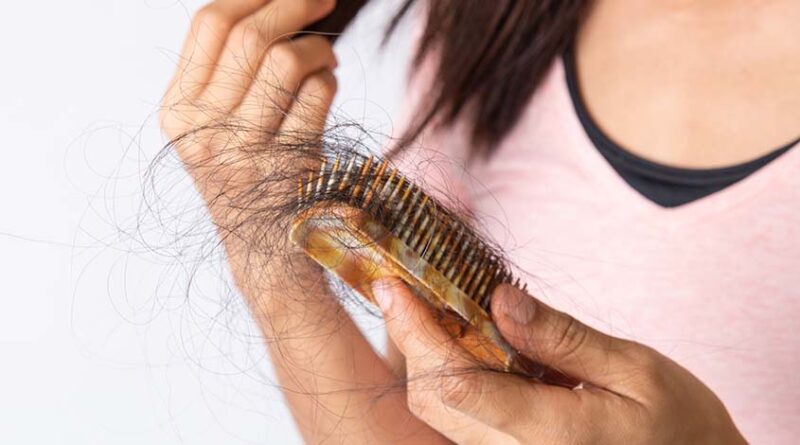Hair Loss Options
First, find out what’s causing the problem
By Deborah Jeanne Sergeant
Anyone concerned about hair loss has many options available for improving the appearance, health and thickness of their hair. To select the correct option, it is important to understand that hair loss differs from case to case.
“There are many causes of hair loss,” said Ron Hebner, owner of New-U Hair Replacement Specialists in Rochester, which has treated clients since the 1980s.
He recommends visiting a primary care doctor to rule out health issues. Changing medication may help avoid the side effect of hair loss, for example.

Some health problems such as bulimia, anorexia and hypothyroidism can cause hair loss, among other symptoms. Shortly after pregnancy, most women experience abrupt, noticeable shedding as their hormones adjust (although this is temporary). People experiencing severe emotional or physical stress often lose hair suddenly.
Once any medical issues have been resolved, Hebner advises seeing a hair professional.
“The key to your success is addressing the issues right away,” he said. “Early treatments will yield the best results. Although most people are looking for that miracle cure, suggested treatments would depend on the individual and results would not be the same for everyone. The best way to determine which option is most suitable for the individual is to meet with a professional.”
Beth Lertzman is board-certified in dermatology and dermatologic surgery.
She is a diplomate of the American Board of Dermatology and the National Board of Medical Examiners and sees patients about hair loss and other concerns at Genesee Valley Dermatology & Laser Centre in Rochester.
In addition to learning about why the hair loss is happening, Lertzman encourages patients to eat right, but not go overboard with nutrients.
“Over-taking zinc or biotin — a lot of people take too much of them when they have hair loss,” Lertzman said. “A healthful diet with the appropriate amount of zinc, vitamin B and vitamin D is good. If you talk with your doctor, they can test to make sure that you have the right levels.”
If you choose to supplement, take a well-known brand and stick with the recommended daily intake of nutrients.
Go easy on your hair. Washing too frequently, using harsh shampoo and using chemical treatments can weaken hair. Avoid styles that pull and break hair, as this makes the hair that is left appear thinner and can damage follicles.

Lertzman said that for some people, over-the-counter minoxidil works well, but for some people they need to keep using it for life to maintain results.
“A lot of the treatments are considered off-label,” she added. “There’s a medicine that’s FDA- approved to lower blood pressure, but we notice a lot of people had hair growth. There are a lot of off-label treatments and a lot of research to make drugs on-label.”
Non-surgical treatments can also include platelet-rich plasma (PRP) injections. This involves a series of office visits in which vials of the patient’s blood are withdrawn. The blood is separated so that the plasma is rich with the patient’s own platelets. This concentrated blood is injected back into the patient, which stimulates the scalp to grow hair. PRP treatments take time to become effective, but patients experience no downtime.
“The platelets can affect the follicles directly,” said physician Alex Montague, who practices at Quatela Center for Hair Restoration in Rochester. He is board-certified by the American Board of Otolaryngology-Head and Neck Surgery, and a member of the American Academy of Otolaryngology and the American Academy of Facial Plastic and Reconstructive Surgery.
Quatela also provides Keralase, a treatment which uses a laser to create little channels in the scalp. That facilitates the absorption of a proprietary growth factor and protein serum, KeraFactor. This stimulates the scalp to get into the growth phase of the hair’s cycle.
Montague said that patients experience no pain or down time and need about six treatments to begin to see results.
In addition to prescribing oral hair growth medication, he also recommends a topical Rogaine/Propecia formula that patients apply twice daily to keep hair in the growth phase.
“Rogaine takes hairs in their dying phase and tries to flip the switch,” Montague said. “Propecia blocks testosterone’s effect on the hair follicles.
“Testosterone causes the majority of hair loss, about 90%. Coming at it with Rogaine and Propecia, you hit it from two different angles. It’s nice in that it’s a nonsurgical option, relatively cheap and you can do it at home.”
These treatments all tend to work best on people who are just beginning to experience thinning. Those with profound, long-term hair loss may not see much improvement.
Hair transplant is the costliest, yet most effective way to restore hair long-term. It may take a week or two before patients look like they normally do, and about six to eight weeks for hair to begin growing. It can take a year before the hair comes in thickly.
The “doll’s hair” effect of hair plugs is what some patients think when they hear “hair transplant,” but Montague said that the technique has advanced so that the results are natural looking. Providers transfer follicular units, not big clumps, for a natural effect. It can take up to a year for hair to feel as soft as the original hair. Most patients who want it as thick as before come back for two or three rounds of transplants.
“In one sitting, you can’t get it to be as thick as the hair God gave you,” Montague said.
The outpatient procedure typically requires local anesthesia and little sedation for relaxing patients and can take eight hours. Patients feel no pain and return home the same day.

